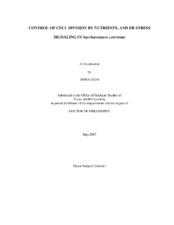| dc.description.abstract | Cell cycle progression of Saccharomyces cerevisiae cells was monitored in
continuous cultures limited for glucose or nitrogen. The G1 cell cycle phase, before
initiation of DNA replication, did not exclusively expand when growth rate decreased.
Especially during nitrogen limitation, non-G1 phases expanded almost as much as G1. In
addition, cell size remained constant as a function of growth rate. These results contrast
with current views that growth requirements are met before initiation of DNA replication,
and suggest that distinct nutrient limitations differentially impinge on cell cycle
progression. Therefore, multiple mechanisms are hypothesized to regulate the
coordination of cell growth and cell division.
Genetic interactions were identified between the dose-dependent cell-cycle
regulator 2 (DCR2) phosphatase and genes involving in secretion/unfolded protein
response pathway, including IRE1, through a genome-wide dominant negative genetic
approach. Accumulation of unfolded proteins in the endoplasmic reticulum triggers the
unfolded protein response (UPR). How the UPR is downregulated is not well
understood. Inositol requirement 1 (IRE1) is an endoplasmic reticulum transmembrane UPR sensor in Saccharomyces cerevisiae. When the UPR is triggered, Ire1p is
autophosphorylated, on Ser 840 and Ser 841, inducing the cytosolic endonuclease
activity of Ire1p, thereby initiating the splicing and translational de-repression of HAC1
mRNA. Homologous to Atf/Creb1 (Hac1p) activates UPR transcription. We found that
that Dcr2p phosphatase functionally and physically interacts with Ire1p. Overexpression
of DCR2, but not of a catalytically inactive DCR2 allele, significantly delays HAC1
splicing and sensitizes cells to the UPR. Furthermore, Dcr2p physically interacts in vivo
with Ire1p-S840E, S841E, which mimics phosphorylated Ire1p, and Dcr2p dephosphorylates
Ire1p in vitro. Our results are consistent with de-phosphorylation of
Ire1p being a mechanism for antagonizing UPR signaling. | en |


